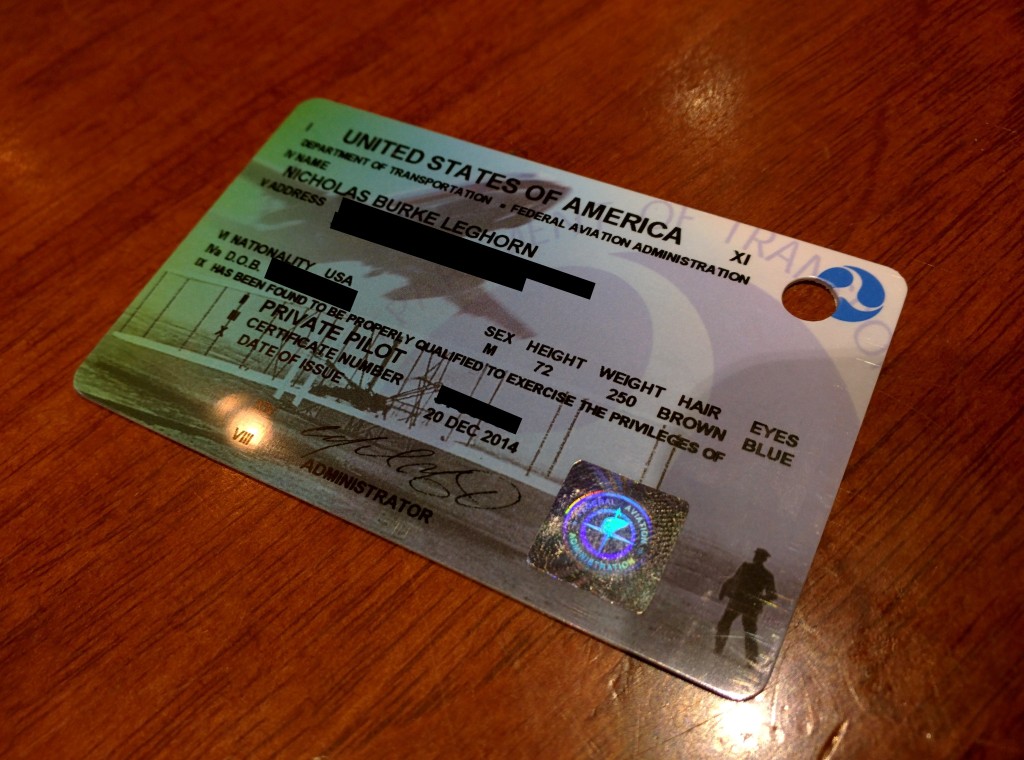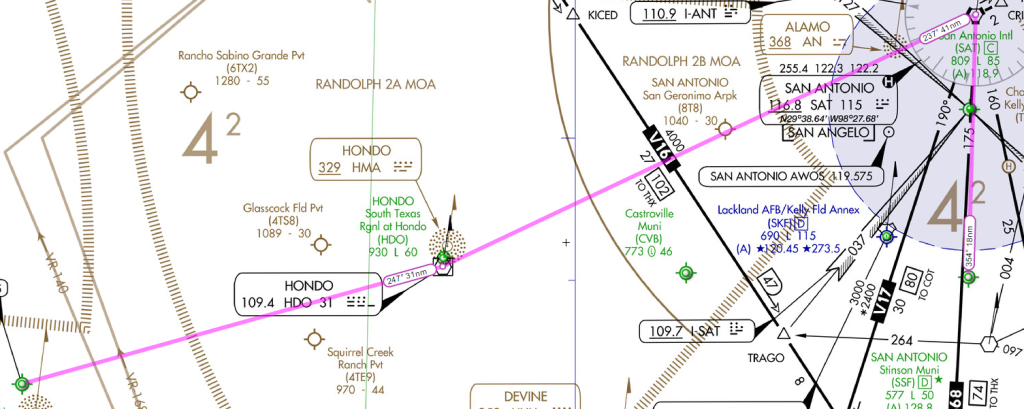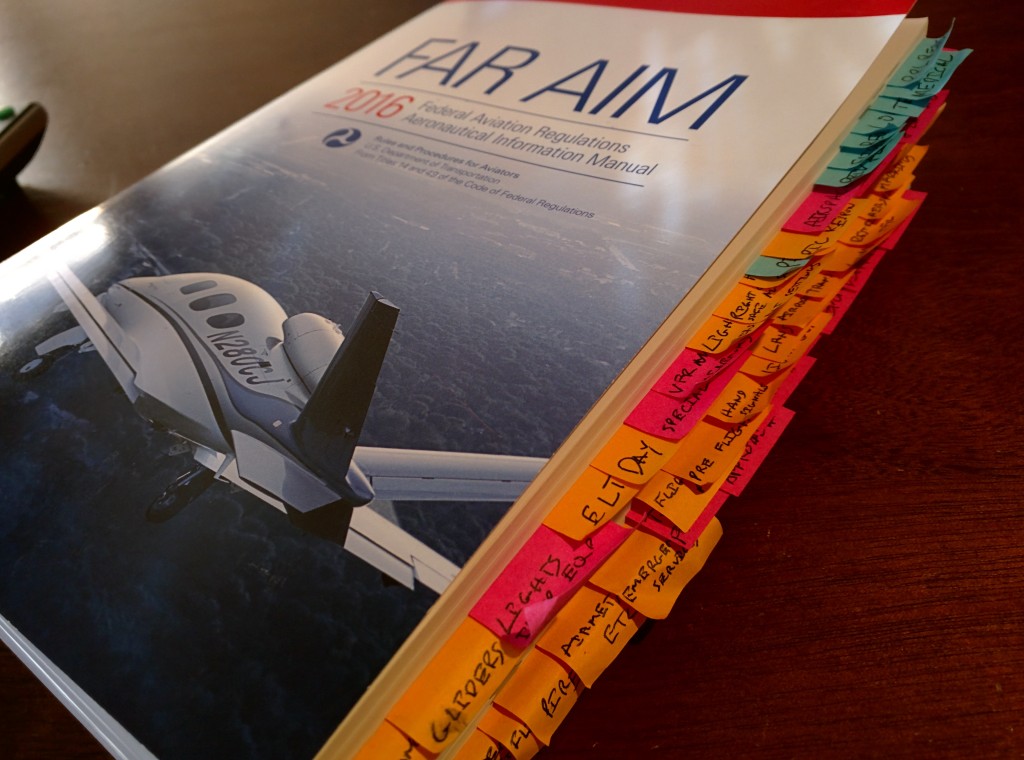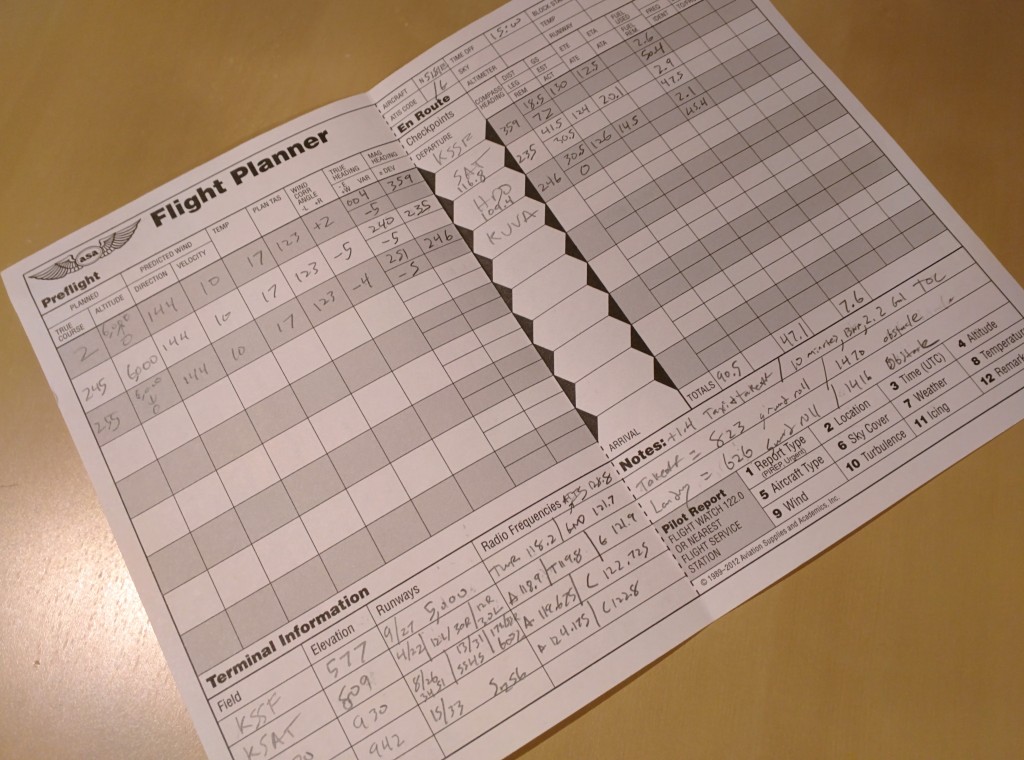When I did my initial EMT training (basic) I always had the goal in mind that one day I would move to the next level and do my paramedic training. Basic EMT stuff is cool, but there are very few drugs they let you touch. Being a newly minted private pilot is basically the same thing — you can go fly around, but the limitations of that certificate make it impossible to do many of the cool cross country flights that you’d want to take. With my EMT training, I figured there would be time for that P later and working as an EMT-B would be rewarding enough in the meantime. I never made it, and I was determined that I wouldn’t let my flying career take the same path. So as soon as I had paid off my private pilot debts I signed up for a Part 141 instrument school, and six months later I took and passed my check ride.
Even before the check ride began I had a minor freak out. The ride was scheduled for August 20th, and the charts I had in my possession expired the morning of the 20th. I briefly considered using the soon-to-be expired charts and backing it up with fresh data from Garmin Pilot, but considering that this was a check ride I didn’t want to give the DPE any excuse to mark me down. I hopped on Sporty’s and ordered a new set of charts with one day shipping. The site said they would get there the Monday before the ride. They arrived early the very next day — Friday morning.
The check ride started the same way my private check ride began. A few days before the event my CFI sent me a text saying that the examiner wanted me to plan a flight to the Uvalde airport. That’s a problem.
Here in San Antonio there are some great nearby airports that are very easy to plan an IFR flight to. Junction is pretty much ideal, which is why I used it as one of the points for my long cross country flight. There’s a departure procedure out of San Antonio that puts you on a direct heading to the airport and everyone is happy. But when you’re heading to Uvalde there is exactly nothing. No departure procedure to that area. No good nearby VOR. Not even a victor airway that goes anywhere close. The reason is that the MOAs for the local military training bases were right on top of that route. Basically the easiest way to file it would be GPS direct, which is possible with the /G 172 I would be flying.
But this is a check ride. That had to be a trap.
I figured that the DPE would want to see a more “correct” IFR routing to that airport, including a departure procedure out of San Antonio. So I took a look through the available procedures and found the BOWIE5 departure, which reads (more or less) “fly to the SAT VOR and then on transition / route.” That would allow me to file “BOWIE5.SAT” as my departure, dropping me off at the VOR, and then I could leapfrog to the Hondo VOR about halfway to the destination and thence direct to the field. Not only would that be the fastest route to take while still using a DP, but if I lost the GPS I could still fly it using only the NAV radios. Here’s that full route:
I spent the rest of the night meticulously calculating all of the assorted and sundry things that one does for a flight — true airspeed, groundspeed with winds aloft, mag heading, fuel used, takeoff and landing distance — all by hand. I wanted to get some last minute practice since I assumed that the DPE would want to see that live and in person the next day. I then laid out the course on a low enroute chart, highlighted the route with a highlighter, and went to bed to get some sleep for the next day.
The morning of the check ride everything seemed perfect. I woke up before my alarm clock and got started with my normal daily routine. The ride was scheduled to begin at 3 PM, so I had plenty of time to relax and catch up on some last minute studying. The one thing I had the most trouble remembering was the laundry list of required reports but after repeating it all morning I had it firmly chiseled into my grey matter. Everything was peachy right up until I checked the weather.
METAR KSSF 201753Z 10010KT 7SM TSRA FEW026 BKN060 OVC090 26/21 A2997 RMK AO2 LTG DSNT ALQDS RAB49 TSB1656 PRESRR SLP138 P0000 60000 T02560211 10311 20256 53022
On my last checkride the day also started out with terrible weather. Low ceilings and poor visibility threatened to shut the whole thing down, and it looked like that same luck was following me once again. The chief pilot of my flight school called me around 1 PM to see what my thoughts were, and while the TAF was calling for thunderstorms all afternoon I had checked Wunderground (which seems to be more accurate and granular) and they were optimistic about that afternoon’s weather. There was definitely a line of thunderstorms moving through the area, but they (as well as my Flight Service briefer) were convinced that the storms would have rolled through by the time I was planning on blasting out of Stinson.
Trusting my sources I decided to press on with the check ride. Worst case scenario, if things were still terrible at our departure time we could discontinue the ride and try again another day. And there’s always the chance that things could clear up as expected and I could be instrument rated by the end of the night, which was ideal.
I arrived at the airport an hour before the check ride so I could grab a quick bite to eat at the airport greasy spoon. The weather was still terrible — I had driven through a rather massive thunderstorm on the way to the airport, and rain was still falling on the field when I sat down for lunch. While I was stuffing a roast beef sandwich into my face the chief pilot rolled in and I asked him one question that seemed very pertinent to my situation: if the clouds didn’t dissipate and the weather was still below VFR minimums, could I accept an IFR clearance during my check ride?
In order to accept an IFR clearance, I need to be (1) instrument rated, (2) current, and (3) in an appropriately equipped and certified aircraft. For the purposes of the check ride I needed to act as pilot in command, since this was a practical test of my PIC capabilities. Since I did not hold an instrument rating I was not qualified to accept an IFR clearance, but I would have an instrument rated DPE in the right hand seat who could. In the mind of the chief pilot this might not be possible, since accepting an IFR clearance on our behalf would require the DPE to take over as PIC for the flight and might not work out. He suggested that I ask for clarification before we started.
Having finished my sandwich I walked over to the FBO to start the check ride. The DPE was ensconced on the couch doing some paperwork when I walked in, and after the usual exchange of pleasantries we started the paperwork for the examination. right before he was about to sign the paperwork in IACRA, he admonished me that this was the last time I could ask my CFII any last minute questions before the exam started and we were “on the clock” — no instruction was permitted on the ride whatsoever. So I asked my CFII that same question (accepting an IFR clearance on the check ride) and the DPE chimed in with some helpful clarification.
Apparently this exact question had come up at a recent meeting, and the guidance they were getting was that a check ride was the sole exception to the rule. A practical test requires the applicant to exercise the privileges of a certificate that they did not yet hold (since the DPE is technically a passenger and the flight is not logged as “dual received”), and this could include accepting IFR clearances. So even if the clouds didn’t lift to the point where we could make the flight in perfect VMC I would in fact be legal in accepting an IFR clearance and we still could get everything done.
Satisfied that there was now a glimmer of hope that we could finish the check ride that day I signed the paperwork and we sat down to begin the oral exam.
The oral started the same way that the private oral did. “What do you need in your possession to fly? How about the aircraft? What inspections do you need? What about currency?” There was definitely a slant towards instrument specific things, but I was able to muddle through without needing to reference the FAR (which I had tabbed out and standing by, just in case).
After a while on administrative regulations we started in on the route planned. I opened up the enroute chart and revealed the fullness of my brilliant departure procedure related scheme. The DPE started at it. Then he stared at me. Then he stared at it again. Then he asked to see the procedures publication to read the DP. Then he started at it some more. And then he asked, “really?” I had a bit of an “oh, shit” moment — the DPE was questioning my route! This was the end of the world! — but after explaining it, he accepted the route and asked me a few questions about altitudes and lost communications procedures while en route. “When can we start the approach? When can we descend from our assigned altitude? How do we identify the missed approach point?”
Satisfied so far, he decided to take a bathroom break and get a drink of water. “While I’m gone, calculate our time enroute, fuel burn, and takeoff and landing distances please.” I looked at him a little funny, then whipped out my pre-planned and calculated route. “I’ve already got it right here, would you like me to do it fresh?” Did he really expect me to show up to a check ride without having done all this in advance? He kind of chuckled, and remarked “if you already have it that’s fine, I’m still going to the bathroom for a couple minutes!” So I sat there and checked the weather waiting for the DPE to come back.
Things were improving rapidly outside. The thunderstorms had moved off, and while the clouds were still lower than I would have liked they were sufficiently high that we could shoot the approaches and do some air work. I might need to accept an IFR clearance, but since that apparently wasn’t an issue I wasn’t worried.
When the DPE came back we started into systems. He framed the systems questions in an icing scenario, which was perfect since that was exactly what the chief pilot had grilled me on in my end of course exam. I had brushed up on that in the meantime and dove straight into explaining the difference between an iced up pitot tube and an iced over static port, how the engine would react to icing on the air filter, and the anti-icing systems on our 172SP (hint: practically none, not even carb heat).
One answer in particular seemed to throw him for a loop. On the 172SP, there are a pair of flaps inside the cowl of the engine compartment that are spring loaded and normally closed. If the air filter on the air intake becomes clogged with ice, the pressure difference will cause the flaps to open and draw air from the cabin and the engine compartment to feed the engine intake and restore some engine performance. He had never heard this before apparently, so he grunted an acceptance to the answer and we moved on.
After a few hours of questions he seemed satisfied that I wasn’t an idiot and started talking about his expectations for the flight portion of the exam. I checked the weather real quick and it looked like things were finally clearing up. Quite literally.
METAR KSSF 202153Z 02005KT 10SM CLR 26/22 A2990 RMK AO2 SLP113 T02610217
There were still some clouds in the area though so we discussed that we would remain VFR as long as possible but having to pick up an IFR clearance wouldn’t be the end of the world. With that we headed out to the airplane to pre-flight.
As soon as we got to the airplane the DPE grabbed the POH from the back seat, flipped to the page about the air intake flaps, and asked me to point them out. I dutifully did so, and he smiled as he put the POH away having apparently learned something from a student on a check ride. I’ll call that a win.
The usual route for a check ride around San Antonio is lovingly referred to as “The Trifecta.” First, you shoot the RNAV (GPS) 33 approach into Castroville. Approach will typically assign a new missed approach procedure to the north, which perfectly sets us up for the ILS 15 approach into Kelly Air Force Base. After a low approach into Kelly its just a quick left turn to the initial approach fix for the VOR 32 approach back into Stinson. That’s what I had practiced so many times that I could do it blind (har har), but the DPE had other ideas. He wanted to see the ILS 12R approach into San Antonio International, which I had done once before but is usually a little busy with commercial flights landing and taking off from the sole airport at the 7th largest city in the United States. I asked if he would prefer Kelly, but he was set on seeing the ILS 12R at San Antonio. I didn’t press the matter.
We departed Stinson VFR en route to Castroville, and on the way the DPE had me perform a couple maneuvers under the hood. Before we could get very far the clouds started coming down and he suggested we get an IFR clearance for the rest of the flight. The DPE took the radio to request the clearance, but when ATC came back and issued it the DPE motioned for me to take the radio. So I, as a non-instrument rated private pilot, legally accepted an IFR clearance as PIC for the first time.
The GPS approach was spot on. At the initial approach fix the instrument covers came out and I did it partial panel, which is my preference — the VOR approach is the harder of the non-precision approaches, and having gyros for that would definitely have a huge impact on my performance. On the missed approach we climed back out and were vectored for sequence to the 12R ILS course.
SAT was pretty busy at the time. There was an American jet holding for takeoff, and a Citation jet wanting to come in for the ILS approach as well. Approach cleared us first, but admonished us to maintain “maximum forward speed” for the approach so that we wouldn’t be squashed on the Citation’s windscreen like a bug. I flew the approach at 120 knots IAS (flirting with the yellow arc) and nailed it.
Going missed approach out of San Antonio, the DPE told me to request a hold over the SSF VOR at 4,000 feet. We would enter the hold, do one complete lap, then ask for the approach when outbound on the second lap. He mentioned later on the ground that this was where he had failed a couple applicants — apparently they had gotten used to starting the approach immediately, and instead of holding at 4,000 feet they started descending to 2,100 (the altitude for the approach hold in lieu of procedure turn) immediately. I flew direct to the SSF VOR, entered my hold (a parallel entry), and started holding as normal.
The wrench in the works: a 30 knot crosswind 90 degrees off our holding course.
This could have been a huge issue. If my outbound legs had been flown exactly on the magnetic heading indicated then we would have drifted into the inbound course and things would have gotten hairy. But since I had a GPS in the airplane I used that to monitor my ground track and ensure that I was really tracking on the outbound course. I still overshot the inbound course almost every time, but I was able to recover and get on track in time to cross the VOR on course and on time.
After the one complete turn in holding I got my clearance for the approach and we circled to land on runway 9. As usual I was way high on final so I chopped the power to idle, set full flaps, and glided down for a normal landing. I have to say that it was one of the best landings I’ve had in months — directly over the thousand footers, gently touching down on the main wheels and coming to a smooth stop.
Back on the ground my CFII and the chief pilot were waiting in the lounge to hear about how it went. The DPE answered their question by punching a hole in my pilot certificate, which was a slightly traumatizing thing to see. The document I had worked so hard to get and spent so much money on achieving was now useless and defaced, replaced again by a printed slip of paper with a promise of a new one coming in the mail. The fact that the new certificate would have the words “instrument airplane” on it was consolation enough, though.
The DPE had two comments for me on the experience. First, he was still confused about the reason I filed a departure procedure that took me towards a busy airport instead of away from their airspace. I explained myself and it made sense to him as well, but we agreed that the plan was definitely something more academic than real world practical. It was correct, but not something you would actually want to fly. The second comment was about the hold, and specifically that the crosswind in the pattern made my hold look closer to a parallel entry than an actual holding pattern. Something I need to work on a bit more, but within the PTS.
That was it. 7 PM and I was an instrument rated private pilot. As I was filling out my logbook, I asked the DPE how much actual IMC time I should log. He chuckled. “The flight was 1.5, log .8 actual.” I had passed my checkride in actual instrument conditions, which I thought was pretty cool. It was definitely a ton of fun, nothing at all like the grilling I was expecting. I get the feeling that having everything prepared in advance, from the flight plan to the weight and balance and even the fuel consumption figures, earned me some cred in the DPE’s eyes. He commented to my CFII that I was “the most squared away applicant I have ever seen,” something I definitely aim to duplicate when I go for my commercial check ride.
Eventually.



